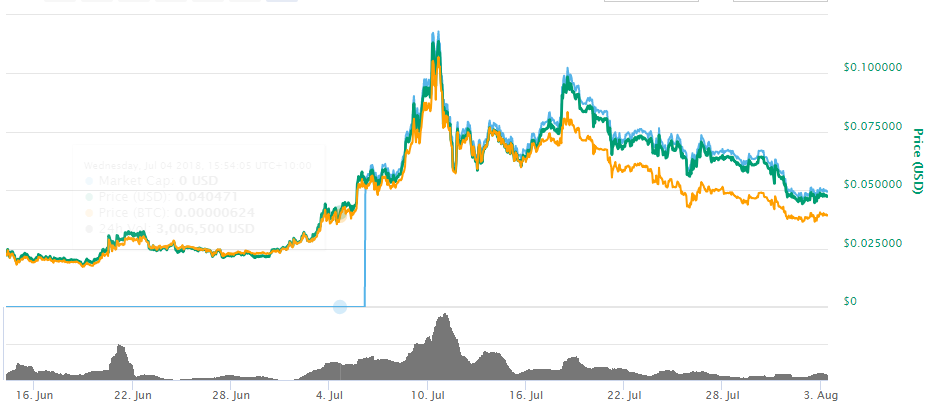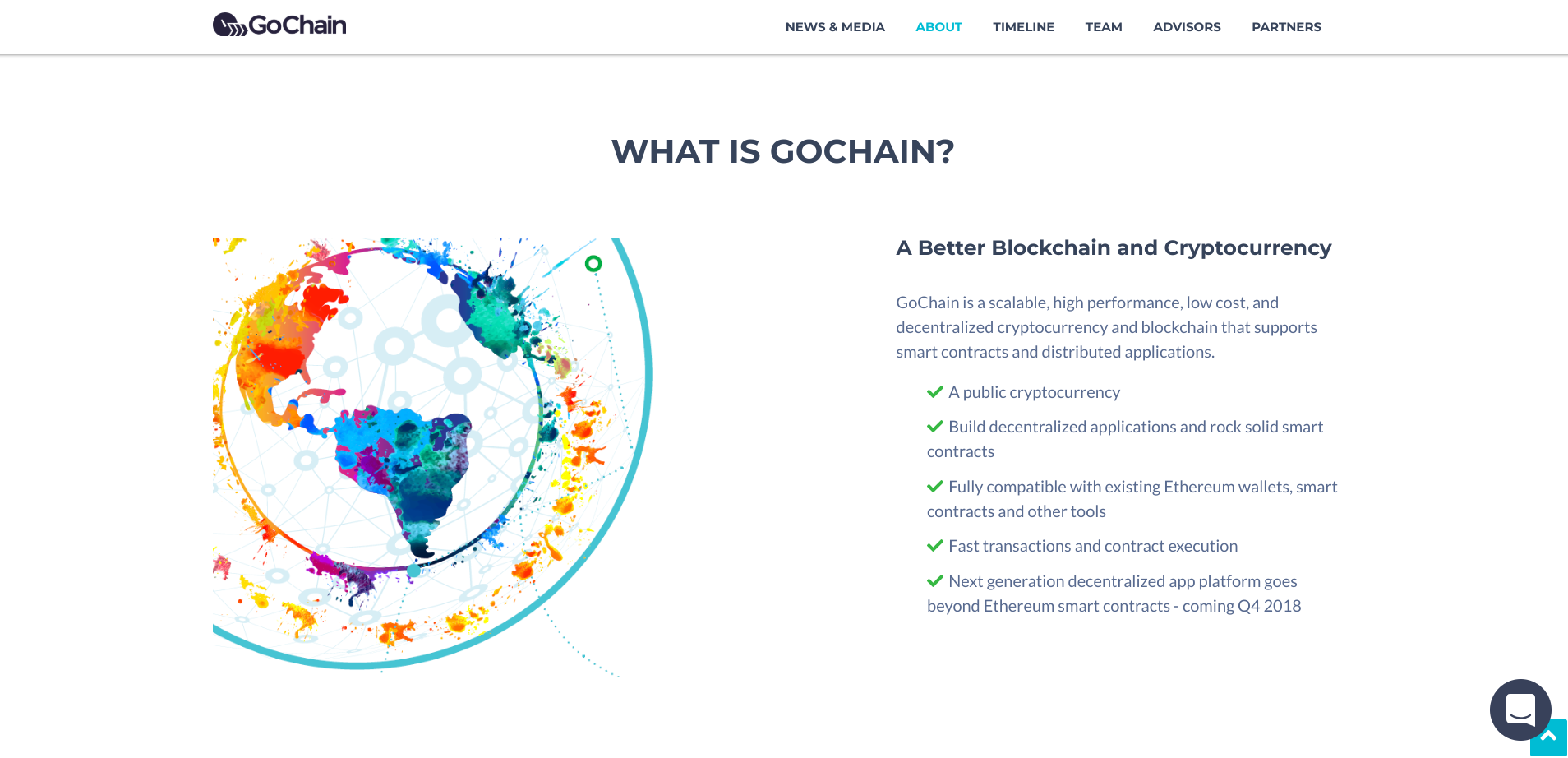“A moment comes, which comes but rarely in history, when we step out from the old to the new,” said Jawaharlal Nehru. To borrow another famous line, the digital revolution has been “one giant leap for mankind”. The interconnectivity of the whole planet presents a unique opportunity married with a daunting scalability problem.
Cryptocurrencies are continually transforming the way we conduct business globally. They are safe, cheap, and easy. The total market cap of cryptocurrencies has skyrocketed from about $15 billion just a couple of years ago to $718 billion. The potential of the blockchain is huge and world-changing. However, there are 3 major issues that are holding back this technology:
- Lack of scalability
- Lack of true decentralization
- Excessive energy use
This is where GoChain comes in.
Contents
Overview of the platform
GoChain is a scalable, high-performance, low-cost, and decentralized cryptocurrency and blockchain that supports smart contracts and distributed applications.
Decentralization is a central tenet of cryptocurrencies. It ensures that no one company or government can control them. However, in practice, almost three-fourths of all blocks are mined by large Chinese companies. GoChain looks to develop a public cryptocurrency built on decentralized applications and smart contracts.
While the likes of Visa are capable of handling more than 50,000 transactions per second, Ethereum lags behind, struggling to process even 20. Therefore, fast transactions and contract executions are key focuses for GoChain.
In regards to interoperability, the platform is fully compatible with existing Ethereum wallets, smart contracts and other tools.
Key Features
As mentioned previously, GoChain looks to provide a scalable, low-cost, energy efficient platform for digital currency and decentralized applications.
Open decentralization does not always work as intended, as noted before. GoChain addresses this concern by forcing nodes to operate from multiple countries, run by traceable, unrelated companies.
GoChain looks to support very high transaction volumes with fast verifications. Initially, it will target 1,300 transactions per second.
The amount of energy used to run the Bitcoin and Ethereum networks is said to be capable of powering over 4 million US households. This raises sustainability concerns. GoChain will use only a small fraction of that energy.
How It All Works
GoChain uses a Proof of Reputation consensus model that depends on the reputation of its participants to keep the network secure. A participant’s reputation has to be high enough so that they ascertain that cheating the system would have punitive consequences for both finances and branding. These participants work as an authoritative node, making it possible for them to create, sign, and distribute blocks to other nodes sans the overhead mining cost.
A list of authorized signers will be maintained on the blockchain. Authorized signers are rewarded with GoChain Coins (GOC) for each block signed. For the initial rollout, there are 50 signers on the authorization list – companies from multiple industries which are spread out across multiple countries. This will enforce decentralization and prevent interference by any single entity.
Companies are identified by their Dun & Bradstreet DUNS numbers, which can be used to obtain official contact information. A secondary verification step requires companies to add a TXT entry to their DNS records with a random token. To enable better decentralization and scalability, a regular checkpoint will be employed. This is a signed snapshot of the current state of the entire blockchain at a particular block number. Once a checkpoint is generated, all previous blocks and data can be removed. This allows nodes to only store a small fraction of the total blockchain that is required for current processing.
A new node will download the latest checkpoint, then continue retrieving blocks and state information from that point on. By using trusted nodes, transactions are verified quickly, and the volume of transactions the network can handle increases manyfold. As there are a small set of signers with known capabilities, the block size can be increased to reduce block times.
Using a trusted network of authoritative nodes means that there will be no mining, and therefore no wasted energy. Signers communicate directly with each other. Thus, the node that has just finished signing will send the just-signed block to other signers on the authorized signers list before sending it to a replication node, offloading blockchain and API queries for the rest of the network. Newer modes reduce the size drastically. Furthermore, limiting the set of nodes operating in the dataset reduces the network traffic and storage requirements.
About the team
The core team is a group of software engineers and business leaders with in-depth knowledge and experience in building high-scale, distributed cloud systems.
Jason Dekker is the Chief Executive Officer. He is a serial entrepreneur, former hedge fund manager, board member, and advisor. He has wide-ranging experience in diverse fields such as finance, biotech, and tech.
Travis Reeder is the Chief Software Architect. He has over two decades of experience with high-scale applications and cloud infrastructure services. Having been involved with resolving scaling issues and delivering scalable services for his entire career, he is now applying that knowledge and experience to blockchain. Travis holds a bachelor’s degree in Computer Science.
Jordan Krage is a Senior Software Engineer with experience in huge data and distributed systems. He is part of the team that developed the Go (golang) dependency management tool. Jordan holds a master’s degree in Computer Science.
Roman Kononov is also a Senior Software Engineer. He brings 12 years of experience developing software and leading engineering teams. His biggest strength is his extensive knowledge and experience in cyber security. Roman holds a master’s degree in Computer Science.
Brooke Hansen is the Social Media Director. She is a blogger and social media guru. Brooke has had a passion for creative expression, channeled through a multitude of outlets including painting, drawing, writing, photography, and modeling. She received a degree in journalism from the University of Nevada at Reno.
Token Performance Details
Introduced into the market earlier this month, GoChain (GO) was initially valued at US$0.05 per token.

GO token lifetime performance chart (courtesy of CoinMarketCap)
While the currency performed admirably in its first week and was worth US$0.11 at one point, it’s since seen a downward trend. Due to the newness of the associated product, it is still difficult to assess the true potential of this token.
As of August 2, the price of a single GO token stands at $0.049.
Final Thoughts
GoChain delivers a highly decentralized and scalable protocol that is both high-performance and low-cost. Owing to its multifaceted nature, it would not be surprising to see this service continue to do well this year.
If you are interested in investing in GoChain, GO trading pairs are currently available on DDEX, IDEX, and OTCBTC.
Image(s): Shutterstock.com


3 Comments